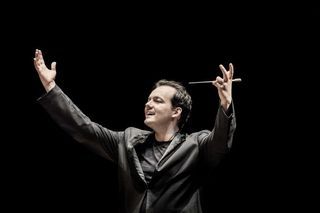|
Back
Mahler and Nelsons Survey the Divine New York
Isaac Stern Auditorium, Carnegie Hall
04/17/2015 - & March 26, 27, 28, 31, 2015 (Boston)
Gustav Mahler: Symphony No. 6 in A Minor
Boston Symphony Orchestra, Andris Nelsons (Music Director/Conductor)

A. Nelsons (© Marco Borggreve)
After the first two movements of this extraordinary achievement, the words ”In Extremis” came to mind. And while these words don’t mean “to the extreme degree”, no other words sufficed. For everything which conductor Andris Nelsons did over the 90-odd minutes of this impossibly challenging symphony, the work which Mahler himself thought too difficult to understand, was taken to the pinnacle, even the excess of emotional experience.
It is doubtful whether conductors approach the Sixth with great joy. In fact, it wasn’t played in Carnegie Hall until four decades after its composition, and this under the fearless Dimitri Mitropoulos. In my unedited score, virtually every single measure is given exact instructions by the composer. And even here, the obstacles are manifold. The microscopic changes of major to minor, the explosive color changes, the tempos lunging forward and held back, all must be directed scrupulously, while simultaneously giving a unified sound.
And if any conductor faces the score of the Sixth, hoping to “please” an audience, that conductor is doomed. The Sixth may have (or, I believe, actually does have) the most gorgeous slow movement since Beethoven’s Ninth, it may have triumphal marches and timpani beats which raise the blood stream. Yet the mere act of listening is such an arduous occurrence that many listeners (like the couple next to me) simply surrender, leaf through the program and mechanically applaud after each movement.
Back, though, to Andris Nelsons. Whatever the Boston Symphony thinks of him (and since they refused to stand up for the applause, giving all the credit to the conductor, he is obviously revered), he made those players exhaust every bone and breath of their bodies. I have heard the Sixth begin with a broad grandiose beginning, but Mr. Nelsons started by cracking the whip with an electrifying beginning. A beginning that was still vibrating in the mind even when that mystical tranquil wind theme started. And while he followed all the score’s directions, he did the virtually impossible, allowing the counterpoint of themes to play transparently through the thickest textures.
Yes, the horns and brass had a few fluffs through the 90 minutes, but they wouldn’t have been human to get through Mr. Nelson’s so physical conducting.
Mahler himself never was certain whether to put the scherzo first or second, but Mr. Nelsons opted to leave the slow movement for a bit. While rarely averse to giving his scherzos relaxing tunes, this was an impossible joke. The Scherzo, he wrote, must be played “weightily”.
So those waltzes, those old-fashioned ländler were played here without a hint of the “old-fashioned” trio also specified by Mahler. These were songs that were awkward, ungainly, and in the trio, almost spooky. Nelsons never allowed his orchestra to give us a respite. He kept it going without reluctance.
And I was so happy that the Andante, that Mahleresque inexorable soul-bearing, could soar before the finale, with the Boston Symphony Orchestra strings at their most golden. They surged, they vibrated, and for the only time in the whole symphony, they showed Mahler, more than Brahms or Wagner, as the only true begetter of the Schubert-Beethoven heritage.
The next paragraph is impossible to write for those who weren’t in Carnegie Hall last night. Mr. Nelsons is more physically impressive than any conductor since Bernstein. No movement is exaggerated, but he uses every movement in the book to beckon and soften, to expand and whisper. He is beautiful to watch (and, unlike Bernstein, I don’t believe a single physical gesture verges on the showy), and the results are beautiful to hear.
The sounds in this finale (modestly entitled by Mahler “Allegro moderato”) were not soaring as in the Andante. They growled and raged, the tubas, trombones, trumpets and nine double basses gave the feeling of hell, even as the themes from the other movements made their way in and out of the texture.
I had the feeling that the very literary Gustav Mahler must have been reading The Divine Comedy here, with purgatory at the top, heaven in the third movement and finally the Inferno at the end. An inferno not only punctuated by that grand percussion section, but by the blows of what seemed to be an eight-foot sledgehammer.
That shocked the audience, and even for those who have heard it before, it shocked us as well. In this way, Mahler and Andris Nelsons were made for each other. Their art is on their sleeves. Neither artist is ever afraid to let the doors of heaven, hell and–in one case–the green earth be depicted.
As mentioned previously about Mahler’s micromanaging, nowhere is this better shown than in the first movement cowbell episode. With all the sounds of Purgatorial agony, Mahler had time to describe exactly how he wanted them.
“The cowbells,” he wrote, “must be handled very discreetly–in realistic imitation of a grazing herd, high– and low-pitched bells resounding from the distance, now all together, now individually.”
Mahler didn’t specify if he wanted the conductor to depict Herefords or Guernseys. But if he had, no doubt Mr. Nelsons would have made the Boston Symphony give us the essence of particular cow breeds, with the same joy triumph and fervency as he consecrated for us this entire momentous evening.
Harry Rolnick
|